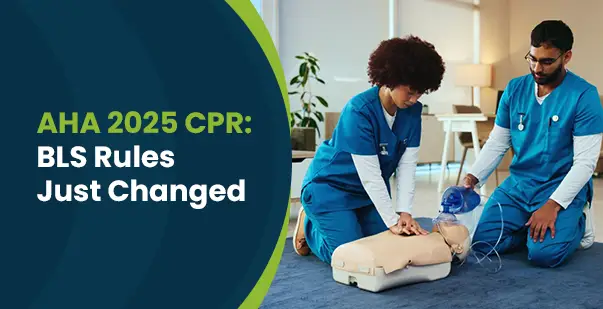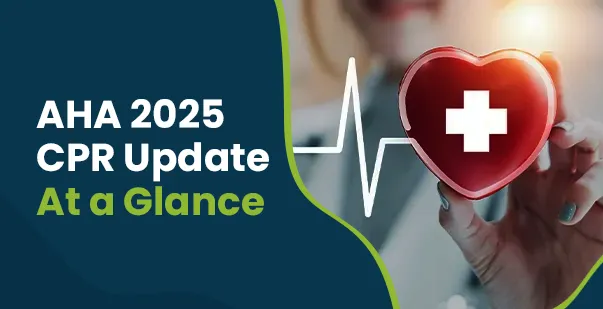What do you do when someone collapses from sudden cardiac arrest? Of course, assist the victim until emergency medical services (EMS) arrive. However, if you do not have the right training or certification, you won’t be able to help the person. That is why it is recommended to have either a basic life support (BLS) or cardiopulmonary resuscitation (CPR) certification. These courses equip you with first aid skills and other relevant techniques to help victims of cardiac, respiratory, choking, or other emergencies.
According to the American Heart Association (AHA), cardiac arrests claim more lives than cancer, pneumonia, house fires, etc., globally. In the U.S. alone, this condition has led to over 436,000 fatalities in a year. This means you must be either BLS or CPR-certified to help more people in your community. To get started, let’s discuss the BLS vs CPR debate in this guide to understand which certification suits you the best.
Is BLS the Same as CPR?
At first glance, BLS and CPR may sound identical, but that’s not the case. While CPR is a core life-saving technique or skill, BLS represents a broader certification program with a proper curriculum.
BLS is designed primarily for healthcare professionals and goes beyond basic resuscitation skills to teach advanced techniques like team-based resuscitation and use of medical equipment. Conversely, anyone can pursue CPR to learn more about techniques like chest compressions and rescue breathing. A proper knowledge of the key differences between CPR vs BLS ensures you do not enroll in the wrong program.
For example, a bystander performing CPR on someone who collapsed in a mall focuses on compressions and rescue breaths. A nurse with BLS training would go further. They coordinate with a team, manage airways and prepare defibrillation equipment during the same emergency.
CPR vs BLS: What’s the Difference?
CPR focuses specifically on chest compressions and rescue breaths until the arrival of emergency medical professionals. Conversely, BLS includes learning about automated external defibrillator (AED) timing, coordinated team roles, and airway adjuncts. Sometimes, it also involves handling special cases like infants or patients who may have experienced obstructed airways. However, BLS does not cover the full structured newborn resuscitation algorithm, which is taught in specialized programs like Neonatal Resuscitation.
The difference between BLS and CPR is clear: the latter is a single technique, while BLS is a structured program for clinical environments. Let’s understand this better in the comparison table below:
| Category | CPR | BLS |
| Scope | Focuses on chest compressions and rescue breaths | Includes CPR plus AED use, choking management, and team-based response |
| Audience | General public, students, non-medical individuals | Healthcare providers, first responders, clinical staff |
| Certification Level | Entry-level training | Professional-level certification |
| Skills Taught | Chest compressions, rescue breaths | CPR, AED operation, two-rescuer coordination, infant/child resuscitation |
| Application | Emergency situations outside hospitals until help arrives | Clinical and pre-hospital settings requiring structured protocols |
| Complexity | Simple, easy to learn | More comprehensive and detailed |
Is BLS Better than CPR?
BLS is not “better” than CPR in every context, but it is simply more advanced compared to the latter. For a layman, CPR is usually enough, while hospitals require BLS. Think of it this way: CPR is like learning basic driving, while BLS is professional driver training. Both are valuable, but one is required only for specialized situations.
So, are CPR and BLS the same?
No, these certifications are not the same. CPR is a subset of BLS. If you have BLS training, you automatically know CPR. However, having CPR certification doesn’t mean you’re trained in BLS.
Read More: Why CPR Training Matters for Senior Caregivers
Do I Need a CPR certification if I Have a BLS?
A common point of confusion is whether holding a BLS certification eliminates the need for a separate CPR certificate.
Since BLS courses already include CPR, most employers and institutions like schools, workplaces, and hospitals accept BLS in place of CPR. However, a few non-healthcare organizations may specifically request CPR certification for compliance reasons. Always confirm with your employer or institution before enrolling.
Does BLS count as CPR Certification?
Yes, in most cases, BLS counts as CPR certification because CPR is embedded within BLS training. If you have completed your BLS course, you have already mastered key CPR techniques for the long run.
BLS CPR
You may often see the term “BLS CPR” in job postings or course titles. This doesn’t refer to two separate certifications because it simply highlights that BLS training includes CPR. Healthcare employers frequently use “BLS CPR” to make it clear that both skills are covered.
What Are the 5 Steps of BLS?
The 5 steps of BLS provide a standardized approach to resuscitation to ensure rescuers act quickly and consistently during emergencies.
These steps are useful for anyone who wants to understand how structured emergency response works. If you memorize these things well, you will be more confident in real-life situations. Let’s discuss them in detail:
Step 1: Scene Safety and Responsiveness
Check the environment to ensure it’s safe enough for you and the victim. Make sure to tap the person and shout to check responsiveness. As a rescuer, you must never put yourself at risk, so ensure scene assessment is done on time for everyone’s safety.
Step 2: Call for Help and Activate EMS
Call emergency medical services immediately if the victim is unresponsive. You may also instruct someone nearby to do it. Early activation of EMS greatly improves survival rates in victims of cardiac arrest or respiratory issues.
Step 3: Assess Breathing and Circulation
Check for chest movement and pulse for no more than 10 seconds. Sometimes, immediate action may be needed if the person in question is not breathing or has no pulse.
Step 4: Begin CPR
Start chest compressions immediately at a rate of 100–120 per minute. Push hard and fast in the center of the chest with the correct depth: about 2 inches (5 cm) for adults, and roughly one-third the chest depth for infants and children. Use a 30:2 compression-to-ventilation ratio if trained in CPR with 30 compressions followed by 2 rescue breaths.
Step 5: Defibrillation with AED
Use an AED on the victim for defibrillation as soon as possible. Modern AEDs already provide voice prompts that guide you through the process. Minimize interruptions in chest compressions because continuous compressions are as important as early defibrillation.
Is BLS the Same as CPR and First Aid?
The terms BLS, CPR, and first aid are often used interchangeably, but they’re not the same. Each serves a different purpose and is intended for a different audience:
- CPR (Cardiopulmonary Resuscitation): Focuses on chest compressions and rescue breaths to restart breathing and circulation during sudden cardiac arrest.
- First Aid: Covers essential care for injuries and illnesses such as bleeding, burns, fractures, or allergic reactions until professional help arrives.
- BLS (Basic Life Support): Includes CPR skills but extends into advanced cardiac and respiratory care, team-based response, and clinical decision-making used by healthcare professionals.
A workplace might require CPR and first aid training for general employees, whereas hospitals and clinics mandate BLS for nurses, doctors, and paramedics. That’s where BLS and CPR diverge most clearly in how and where they’re applied.
Does BLS Include First Aid?
No, most BLS certifications do not include first aid. BLS is designed specifically for managing cardiac arrest, respiratory failure, and other life-threatening events in healthcare settings.
If you need skills to handle injuries like cuts, burns, or broken bones, you’ll likely need a separate First Aid course or a combined CPR + First Aid certification. These are widely required in non-clinical environments across the U.S., including:
- Schools and daycare centers to meet state childcare and education safety requirements.
- Corporate offices and warehouses to comply with OSHA workplace safety standards.
- Fitness centers, community facilities, and recreational programs, where staff are expected to respond to common injuries and emergencies.
Meanwhile, BLS certification remains the gold standard in clinical settings, where healthcare teams manage emergencies with advanced interventions and coordinated response protocols.
Read More: CPR, First Aid & ADA With Course Accessibility Features
What Are the Differences between BLS and CPR Certification?
CPR certification is specifically for the general public, so that they understand key topics like chest compressions and rescue breaths. This allows them to help victims in emergencies across public places like offices, schools, and other institutions.
BLS certification, on the other hand, includes both CPR and other advanced topics like AED usage and team-based resuscitation. The key difference between BLS and CPR certification lies in their respective scopes, as mentioned below:
| Aspect | CPR Certification | BLS Certification |
| Audience | General public and workplaces | Healthcare workers |
| Content | Chest compressions and rescue breathing | CPR, AED, multi-rescuer skills, or airway management |
| Duration | 2 to 4 hours | 4 to 6 hours |
| Certification Validity | 2 years | 2 years |
| Cost | Lower | Slightly higher |
Does BLS Count as CPR Certification?
This is worth emphasising again because many learners hesitate when choosing a course. Employers typically accept BLS as proof of CPR skills, but not always the other way around. So if you’re wondering whether to get both, BLS usually covers all requirements, especially for healthcare roles.
How Do I Find a BLS Certification Near Me?
Searching for BLS certification near me will bring up multiple options from local hospitals, training centres, and accredited organisations.
The American Heart Association and Red Cross are the two biggest providers, but many hospitals partner with them to deliver on-site courses. Some employers also offer in-house training for staff.
How to find classes
The easiest way is to use the AHA’s official course finder. You can choose between in-person, blended, or even online courses that end with a practical skills check.
Does BLS Include First Aid?
This question often arises among non-healthcare professionals. While CPR + First Aid courses are common for workplaces, BLS training rarely includes First Aid.
BLS vs CPR training
BLS vs CPR training comes down to audience and scope. CPR training often pairs with First Aid for everyday emergencies, while BLS is a standalone advanced program meant for healthcare providers.
Is BLS CPR mandatory for Healthcare Workers?
Yes. Nurses, EMTs, and medical students must hold a valid BLS CPR certification. It ensures all professionals can deliver consistent, high-quality resuscitation across clinical teams. BLS certification includes CPR training, so hospitals require it, and most clinical employers won’t hire without it.
How to Get a BLS Certification?
The process is straightforward, but choosing an accredited provider is important to ensure the certification is recognised.
You typically enrol online, complete theory lessons, attend an in-person or blended practical session, and pass a skills test. After this, you’ll receive a certification card valid for two years.
Renewal Requirements
Just like CPR, BLS certifications expire. You’ll need to take a renewal course every two years to stay updated with the latest guidelines.
BLS vs CPR AED: What Are the Differences?
AED training is where CPR and BLS overlap most directly. Both certifications cover AED use, but the level of training differs.
CPR AED training teaches lay rescuers how to use defibrillators in public settings. BLS AED training, however, prepares healthcare professionals to use AEDs in complex, team-based clinical situations. In hospitals and advanced care settings, AEDs are often part of a crash cart system, working alongside other life-saving tools and coordinated team actions, not just standalone units.
| Feature | CPR AED | BLS AED |
| Audience | General public | Healthcare staff |
| AED Use | Basic, guided prompts | Advanced team integration |
| Focus | Single rescuer, basic survival | Multi-rescuer, professional environment |
BLS vs CPR: Which is Better?
BLS and CPR are closely linked, but they serve different purposes. CPR gives anyone the ability to respond in an emergency, while BLS equips healthcare providers with advanced techniques and structured protocols.
In summary, BLS vs CPR is about understanding your responsibilities in depth. If you are deciding between the two, think about your role. For parents, teachers, and everyday citizens, CPR training is often enough. For nurses, doctors, and medical students, BLS is usually a key requirement.
No matter which certification you choose, the most important step is to get trained. So, enroll in a BLS CPR First Aid certification now.









